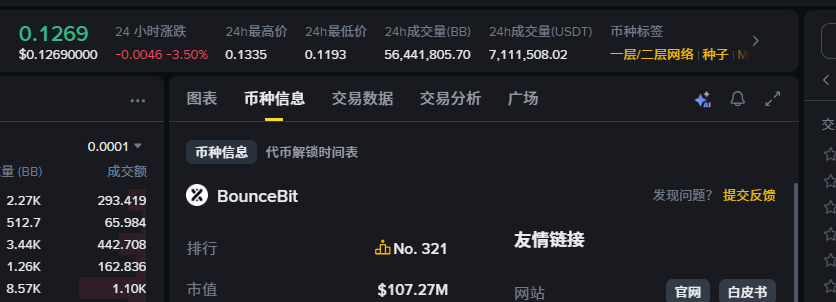When the market was swept by the frenzy of Meme coins, I quietly did one thing: I converted 30% of my position into BounceBit. It wasn't following the trend, but because its data convinced me—stable cash flow is more valuable than a brief surge in such a volatile market.
Technical Breakdown: How CeDeFi Achieves Real Returns
As a technician, what I care most about is whether the source of returns is reliable. BounceBit's architectural design is quite clever:
Asset Anchoring Mechanism:
User-deposited BTC/USDT goes directly into the custodial accounts of Mellon Bank and CEFFU
The custodian allocates these assets to BlackRock's money market fund and short-term government bonds
On-chain smart contracts automatically distribute yield every day
According to the official May audit report:
Total custody assets: $1.83 billion
Actual allocation of RWA ratio: 89%
Average daily yield distribution: about $280,000
Node network security:
Currently running 150 active verification nodes
Each node needs to stake 200,000 BB (about $120,000)
Node offline penalty mechanism ensures 99.7% online rate
Yield analysis: opportunities and risks behind the numbers
From the perspective of DeFi architects, BounceBit's yield model is very appealing:
Actual yield composition:
Base US Treasury yield: 4.8%-5.2%
Re-staking enhances yield: 0.6%-0.8%
Net yield after deducting custody and management fees: 5.2%-5.8%
Comparison data:
Traditional currency funds: 1.2%-1.8%
Bank large certificates of deposit: 2.5%-3.5%
BounceBit net yield: 5.2%-5.8%
But risks also need to be faced:
Custody risk: assets are held by a third party, and although multi-signature is used, there is still the possibility of single points of failure
Interest rate risk: if the Federal Reserve cuts rates, base yield may drop to 3.5%-4%
Liquidity risk: redemption requires 1-3 days of processing time, unable to cope with sudden market fluctuations
The truth revealed by on-chain data
I analyzed on-chain data from the last 30 days:
Number of large wallets (holding >$100,000) increased by 23%
Average holding time: 87 days
Daily redemption volume accounts for only 0.8% of TVL, indicating strong capital stability
This data tells me that smart money is treating BounceBit as an asset allocation 'stabilizer'.
Three key decision points
If you are considering participating:
1. Suitable audience: BTC holders seeking stable yields, institutional funds
2. Timing of entry: allocate during increased market volatility, acting as a ballast for the asset portfolio
3. Positioning advice: no more than 30% of total positions, maintain liquidity
Soul searching questions
When you can achieve a stable yield of 5.8%, would you still invest all funds in high-volatility meme coins? More importantly, if the market enters a correction period in the next six months, would you prefer your assets to shrink in volatility or appreciate steadily?
Recommended practical tools
Yield calculator: input holding amount to estimate daily yield
Node monitoring panel: view network health status in real-time
Redemption time tracking: grasp the flow of funds
Value reassessment: the deeper meaning beyond yield
What BounceBit has inspired me most is not the yield itself, but the possibility it represents—cryptographic assets can move away from relying on market sentiment to generate real cash flow.
When BTC can provide stable yields like bonds, and digital assets can anchor real-world interest rates, the industry will truly mature. BounceBit may not be the final answer, but it is indeed exploring a path for cryptographic assets to gain intrinsic value.
In this uncertain market, sometimes the 'most boring' choice is the wisest. After all, hot money comes and goes, but cash flow never lies.
@BounceBit #BounceBitPrime $BB


